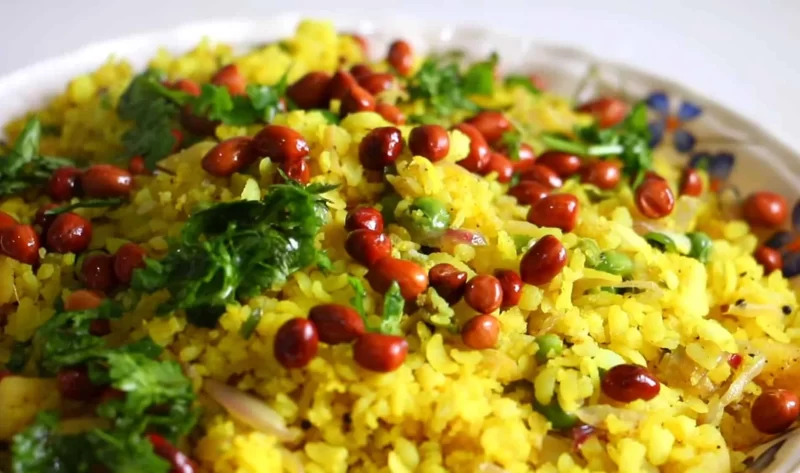Poha Recipe in Hindi: Enjoy a quick and delightful Indian breakfast with this easy Poha recipe, also known as Pohe. Poha is made from flattened rice, combined with onions, spices, herbs, lemon juice, and peanuts. In just 20 minutes, you can create a refreshing, lemony Poha that you’ll love. Serve it as is or enhance it with crunchy sev, fresh onions, or grated coconut. For a complete meal, pair it with plain yogurt and a vegetable salad on the side.
What is Poha?
Poha, or flattened rice, is steam-cooked with onions, spices, and herbs. The term “poha” refers both to the flattened rice itself and the dish made from it. These flattened rice flakes, also known as parched rice or beaten rice, are considered nutritious and wholesome due to minimal processing.
Flattened rice is widely used across India in various dishes like chivda, upma, dosa, idli, and more. Poha recipe stands out as a commonly enjoyed dish with numerous regional variations.
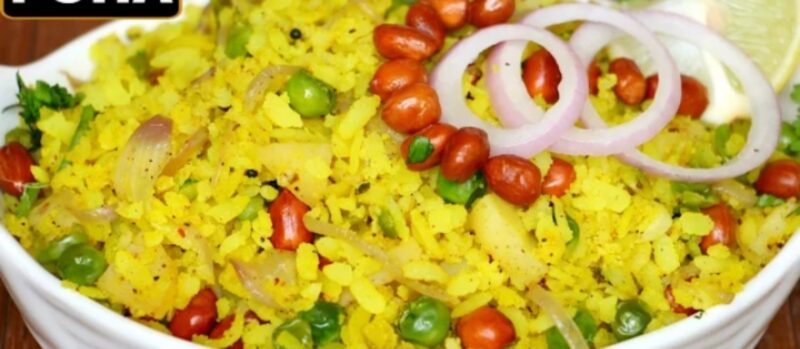
How to Make Poha Recipe in Hindi:
Step by Step Guide
- Clean 1½ cups of poha, ensuring you use thick or medium flakes for a non-sticky result. Rinse quickly to avoid mushiness and drain the water completely. Repeat the rinse process if needed.
- Meanwhile, chop 1 medium-sized onion, 1-2 green chilies, and rinse curry leaves and coriander leaves. If using potatoes, chop them into half-inch cubes and keep them immersed in water until needed.
- Check if poha has softened, press between your thumb and forefinger, and break lumps if any. Add salt and sugar (optional) and set aside.
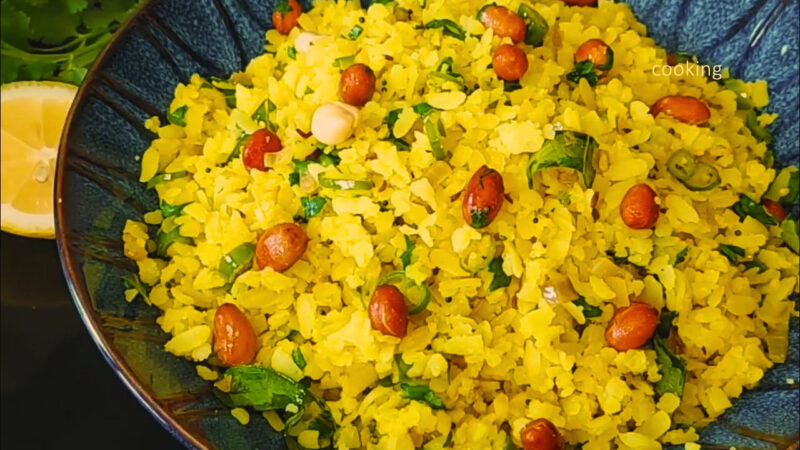
Temper for Poha Recipe
- Heat a pan, fry peanuts until golden, and set aside. Heat the same pan, add oil, mustard seeds, and cumin seeds. Let them splutter.
- Add chopped onions, green chilies, and curry leaves. Saute until onions turn pink. If using potatoes, add cubes and sauté.
- Cover and cook on low heat until potatoes are soft. Add more oil if needed. When cooked, sauté on high flame for 1-2 mins. Add turmeric.
- Add softened poha, mix well, cover, and steam on low heat until hot. Sprinkle coriander leaves and roasted peanuts.
- Take it off the heat, add more salt if needed, and lemon juice. Keep it covered until served.
- Garnish with chopped coriander leaves and roasted peanuts. also add grated coconut or crunchy sev for extra flavor.
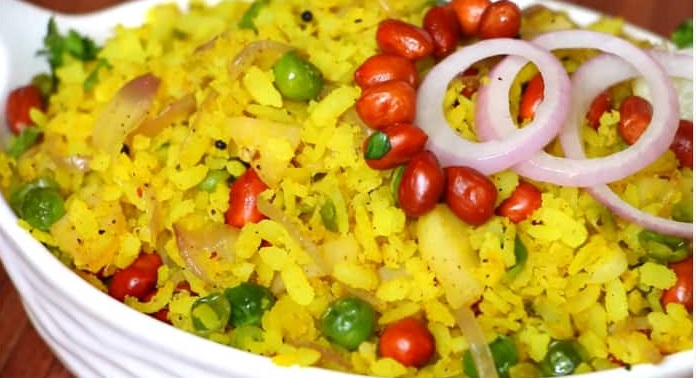
Pro Tips
for Making Delicious Poha Recipe:
Pro Tips:
Choosing Poha:
- Selecting the right type of poha is crucial for this recipe. Always opt for medium to thick poha flakes and avoid the thin ones, as the thin variety tends to become mushy when rinsed.
Testing Poha – A Tip for Newbies:
- For those new to making Poha recipe, a simple test can be performed. Rinse a spoonful of poha in a small amount of water and drain completely. If the flakes do not turn mushy, they are suitable for this recipe. In case they do turn mushy, consider using them to make dadpe pohe (recipe 2).
Rinsing Poha:
- Avoid over-rinsing or soaking the poha, as excessive water can lead to mushiness. A standard practice is to rinse them twice, draining the water completely. Cover and set aside until the tempering is ready.
Checking Poha Softness After Onion Chopping:
- After chopping the onions, check the poha’s softness by pressing a few flakes between the thumb and forefinger. They should break easily. If not, sprinkle some water, mix, and cover until needed.
Adding Veggies for Health:
- For a healthier and balanced dish, incorporate various finely chopped veggies such as carrots, peas, and capsicum. Alternatively, skip the onions and use finely chopped cabbage. Blanch the cabbage in hot water for 2 to 3 minutes before adding it similarly to onions. Feel free to use any vegetables you prefer in your poha.
Toppings for Flavor:
- Poha is typically garnished with fresh grated coconut, crunchy peanuts, sev, or farsan. Even peanuts alone can add a delightful crunch to the dish.
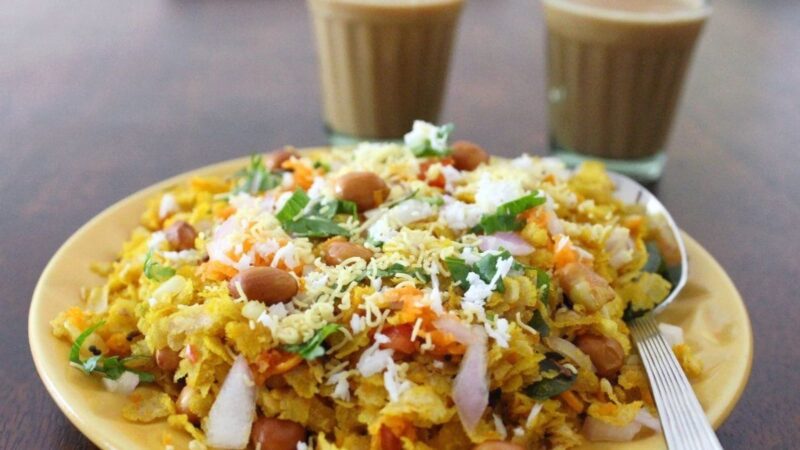
Make-Ahead:
Prepare the tempering in advance. Cool, cover, and store the pan/pot in the fridge. When ready to eat, rinse the flattened rice, soften them, add to the tempering, and mix. Steam on low heat, and your poha will be ready in no time.
Conclusion
In summary, medium poha flakes, brief rinsing, and flavorful toppings are key for delicious Poha recipe. Follow the photos and tips to enjoy this versatile Indian breakfast dish with regional twists!
Frequently Asked Questions
About Poha Recipe in Hindi
What type of poha works best for this recipe?
Medium to thick poha flakes are ideal to get a non-mushy texture. Thin flakes tend to become soggy when rinsed, so avoid using those.
How can I check if the poha is good quality before cooking?
Do a simple rinse test with a small portion. If the flakes don’t turn mushy when rinsed and drained, the poha is good to use. If it becomes mushy, it’s better for other dishes like dadpe pohe.
Is rinsing the poha necessary?
Yes, rinsing the poha is crucial but don’t overdo it. Rinse just twice, drain thoroughly, and set aside until ready to add the tempering. Too much rinsing or soaking will make the Poha recipe mushy.
Can I add veggies to make it healthier?
Definitely! Chopped carrots, peas, capsicum enhance nutrition. Skip onions and use blanched finely chopped cabbage instead for a low-carb option.
What are some tasty topping ideas?
Popular toppings are grated coconut, crunchy peanuts, sev, or farsan. But even just peanuts add nice texture and crunch. Get creative with your own favorite toppings!

